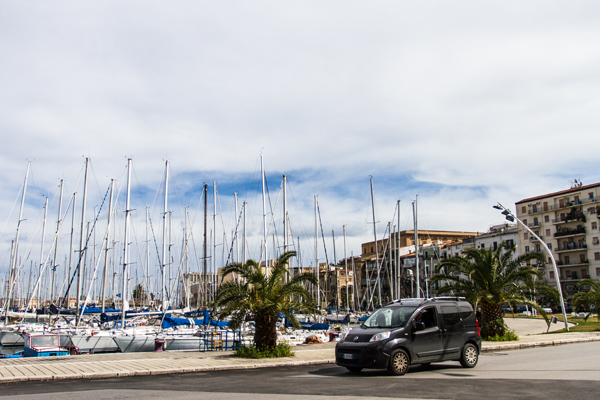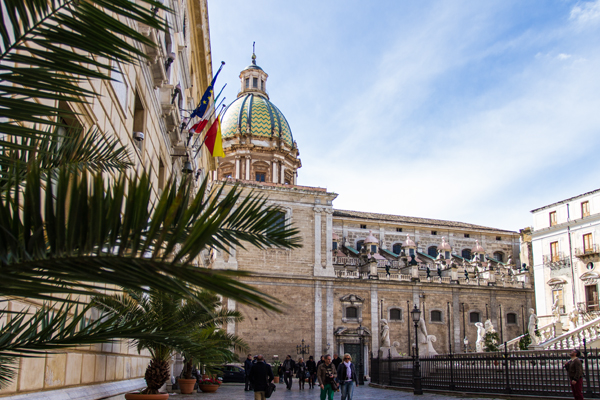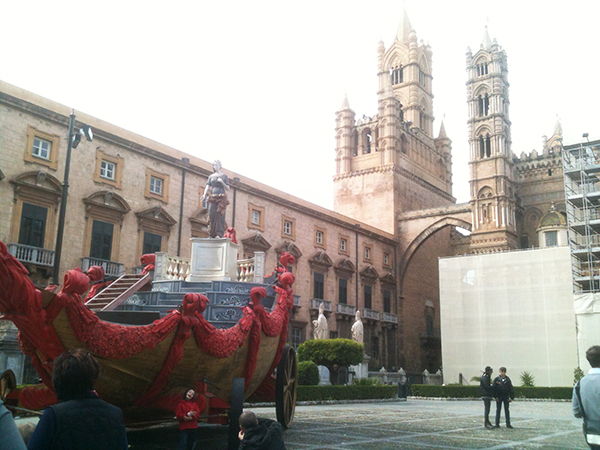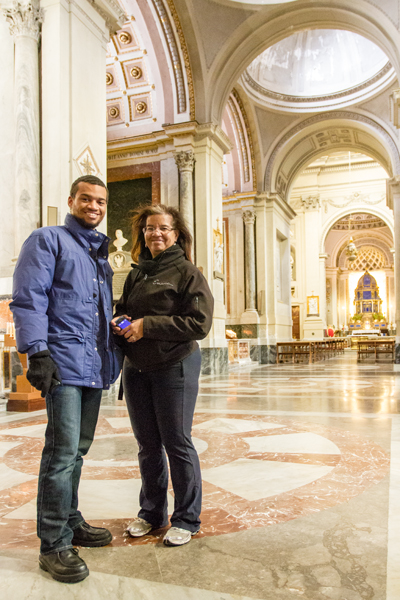Our Travels – Palermo, Italy
Our next port of call- Palermo, Sicily!
Palermo is an ancient city with a very modern vibe. Since it’s founding in 734 BC by the Phoenicians, who named it Ziz (‘flower’), it’s passed through the hands of the Greeks, the Roman Empire, the Arabs and then the Normans. Following the Norman reconquest, Palermo became capital of a new kingdom (from 1130 to 1816), the Kingdom of Sicily. Eventually it would be united with the Kingdom of Naples to form the Two Sicilies until the Italian unification of 1860. Courtesy of Wikipedia
Under the Arabs, Panormos (as it had been renamed by the Greeks) became known as Balarm and was famous for it’s wonderful gardens, beautiful mosques and luxurious palaces.
Unlike Naples, we didn’t have a definite gameplan, so after disembarkation we decided to check out the tourism kiosk just outside the gate and wander around on our own.
En route we were intercepted by a tour guide with a horse and carriage, and it sounded like a great way to see the city-except the size of the carriage really didn’t work for 5 adults. If anyone had filmed them trying to fit us all into the carriage it would have looked like the clowns in a clown car! After several minutes of discussion, my mother in law said, “No, this is not going to work!” Say what you like, but in Sicily, when Mama says ‘No’, the discussion comes to an end. And so it was for us.
Regrouping at the tourist kiosk across the street from the port.
So, we moved on. Our next encounter was with the Calessinos, which are essentially motorbikes with covered seating for 3-4 people, and again- the drivers tried to convince us it would seat 5. With our first lesson fresh in our minds, Mama said no, and we prepared to move on, but these guys knew their business, and quickly brought over a 2nd Calessino (at no extra charge) to accommodate us. And then we were on our way!
Our first stop was the Quattro Canti, officially known as Piazza Vigliena, which is a Baroque square in Palermo. It was laid out on the orders of the Viceroys between 1608-1620 by Giulio Lasso at the crossing of the two principal streets in Palermo, the Via Maqueda and the Corso Vittorio Emanuele. Courtesy of Wikipedia
The piazza is octagonal, four sides being the streets; the remaining four sides are the Baroque buildings, the near-identical facades of which contain fountains with statues of the four seasons, the four Spanish kings of Sicily, and of the patronesses of Palermo, (Cristina, Ninfa, Olivia, and Agatha). The facades onto the interchange are curved, and rise to four floors; the fountains rise to the height of the second floor, the third and fourth floors contain the statues in niches. At the time the piazza was built, it was one of the first major examples of town planning in Europe. Courtesy of Wikipedia.
Right around the corner, we made our next stop at Santa Caterina of Alexandria Church. We were so taken by the beauty of Piazza Pretoria, we forgot to explore the inside of the church!
The phenomenal thing about sharing our experiences, is the research that goes into the writing. Learning all of the history- the who, what and why of the places we’ve visited. I mention this because the Piazza Pretoria, that we shamelessly posed and snapped photos of, is known locally as Fontana della Vergogna, or Fountain of Shame.
So, the story is that the local Senate in 1573, wanted to show off the city’s waterworks system, so they purchased this magnificent fountain originally intended for a private villa or palace, there appears to be some debate about just who’s residence it was, but definitely someone with lavish tastes and the means to fund them.
The fountain includes sixteen nude statues of the goddesses, gods, nymphs, monsters and other figures central to Greek mythology. Mind you, this fountain is sitting between two churches-Santa Caterina and San Giuseppe dei Teatini. The sight of all of these nude, frolicking pagans did not sit well with the locals, especially while they were en route to Mass. And that is how the square was unofficially renamed Fontana della Vergogna.
Our journey continued as we sped past several lovely churches and official buildings. This is the Church of Santa Maria dell’Ammiraglio or San Nicolò dei Greci, commonly called the Martorana, overlooking the renowned Piazza Bellini in Palermo. It is currently the Co-Cathedral of the Eparchy of Piana degli Albanesi of the Catholic Church of Byzantine rite in Sicily. Courtesy of Wikipedia
Below is the Palazzo dei Normanni (in English, Palace of the Normans) or Royal Palace of Palermo. It was the seat of the Kings of Sicily during the Norman domination and served afterwards as the main seat of power for the subsequent rulers of Sicily. Today it is the seat of the regional parliament of Sicily. The palace stands in what is the highest point of the ancient centre of the city, just above the first Punic settlements, whose remains can still be found in the basement. Courtesy of Wikipedia
From the sweeping lawns, and manicured grounds of the Royal Palace, we turned a corner and found ourselves cruising by the most famous market in Palermo. The Vucciria market is aptly named; in the local dialect vicciria means “voices” or “hubbub” and there’s a definite buzz around this market from all of the voices haggling back and forth! It flows through the side streets around the Piazza San Domenico.
The Vucciria market is open Monday through Saturday from around dawn until 2 pm, which is true for most of the markets in Palermo. You’ll find a wide variety of fresh seafood, herbs, local produce, souvenirs and local handcrafts available, but for the freshest of the fresh, you’ll need to arrive before 10 am.
Our next stop was Palermo Cathedral, the cathedral church of the Roman Catholic Archdiocese of Palermo. As an architectural complex, it is characterized by the presence of different styles, due to a long history of additions, alterations and restorations, the last of which occurred in the 18th century. The church was erected in 1185 by Walter Ophamil (or Walter of the Mill), the Anglo-Norman archbishop of Palermo and King William II’s minister, on the area of an earlier Byzantine basilica. By all accounts this earlier church was founded by St. Gregory and was later turned into a mosque by the Saracens after their conquest of the city in the 9th century. Ophamil is buried in a sarcophagus in the church’s crypt. The medieval edifice had a basilica plan with three apses, of which only some minor architectural elements survive today.
In front of the cathedral is a float from the Festino di Santa Rosalia, or Festival of Saint Rosalie. Santa Rosalia is revered as the patron saint of Palermo. According to legend, Rosalia was born in 1130, the daughter of well-to-do Sicilian nobleman. At a young age, she gave up the life of nobility for a solitary one of prayer, spending her days in a cave on Mount Pellegrino, north of Palermo. It’s believed that she died there in 1166.
Hundreds of years later in 1624, Palermo was beset by a plague, and a vision of Santa Rosalia is said to have appeared to a sick woman and then a fisherman. In the vision, Rosalia told the fisherman where to find her bones and to take them to Palermo, where they should be carried through the city.
He followed her directions and found her remains in the cave. The plague stopped after the procession, so Palermitans believe it was a miracle, and in her honor, hold a festival each year in July. The float and statue of Santa Rosalia are the centerpiece of a parade during the festival.
The inside of the cathedral was simply awe inspiring!
The Cathedral has a heliometer (solar “observatory”) of 1690, one of a number built in Italy in the 17th and 18th centuries. The device itself is quite simple: a tiny hole in one of the minor domes acts as Pinhole camera, projecting an image of the sun onto the floor at solar noon (12:00 in winter, 13:00 in summer). There is a bronze line, la Meridiana on the floor, running precisely N/S. The ends of the line mark the positions as at the summer and winter solstices; signs of the zodiac show the various other dates throughout the year.
The purpose of the instrument was to standardise the measurement of time and the calendar. The convention in Sicily had been that the (24 hour) day was measured from the moment of sun-rise, which of course meant that no two locations had the same time and, more importantly, did not have the same time as in St. Peter’s Basilica in Rome. It was also important to know when the Vernal Equinox occurred, to provide the correct date for Easter. Courtesy of Wikipedia
Hmmm, looks like it’s time to take a break from touring! We’re off to enjoy some wonderful Sicilian specialties! We popped into Pizzeria La Duchessa located at Principe di Belmonte 69 / 71…
YUMMM!! Excellent pizza, the salad was fresh, although somewhat unimaginative; overall a lovely place to wait out a surprise rainstorm.
When in Sicily, do as the Sicilians do…legend says that gelato originated from the snow of nearby Mount Etna. Who am I to argue!?!
The Politeama or Politeama Garibaldi is a theater building in Palermo. It was designed and built from 1867 to 1874 by Giuseppe Damiani Almeyda in the neoclassic style. Almeyda was inspired by buildings from Pompeii. Courtesy of Wikipedia
Heading home to the Costa Serena.
Arrividerci Palermo!
I just love these amazing views of the city from our balcony…
The Cassaro or Corso Vittorio Emanuele is the oldest street of Palermo.
The road was traced with the creation of the city itself by the Phoenicians , and cut into two parts agglomeration connecting the port to the original necropolis located immediately behind the city. In the Arab era became the axis main characteristic of urban Arab from which branches off the various secondary roads or Darbi that were attached at right angles to this, and then they go to entanglement in the territory ending in aziqqa, blind alleys typical of downtown. The most important change to its tracing occurred in the second half of the sixteenth century, a period in which the city is the capital of the Spanish viceroyalty.
Author: Desiree Carter
Photos: ©Cedric Carter





































































